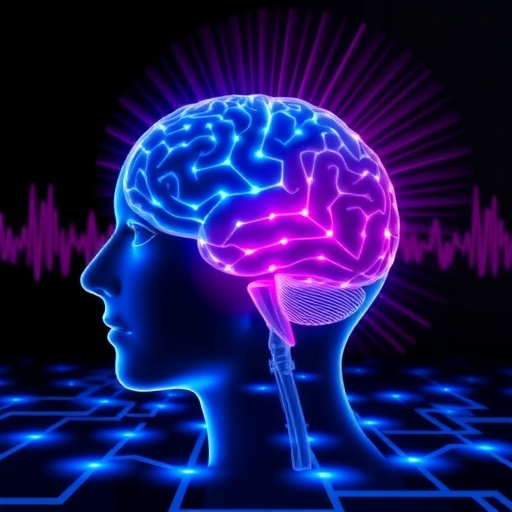In the realm of brain research and neurological therapies, a groundbreaking advancement has emerged from the collaborative efforts of scientists at ETH Zurich, the University of Zurich, and New York University. Their pioneering work enhances ultrasonic neuromodulation, enabling simultaneous stimulation of multiple, precisely targeted brain regions through the skull without invasive surgery. This innovative approach promises to revolutionize how we influence neural circuits, advancing potential treatments for a spectrum of neurological disorders.
Ultrasonic technology has long been a versatile tool across medical fields, from prenatal imaging to physical therapy techniques that apply focused heat to body tissues. More recently, its use has expanded into oncology, where high-intensity ultrasound helps eradicate tumors via localized thermal effects. Harnessing the subtler effects of low-intensity ultrasound presents an alluring frontier: influencing brain activity in a manner that is both precise and non-invasive.
Neuromodulation through ultrasound involves generating acoustic waves that can alter neural excitability and firing patterns. Conventional methods have been limited to stimulating one focal point at a time, a constraint that restricts the capacity to modulate complex brain networks. The brain’s intricate functionality depends heavily on networks that span multiple interconnected regions, making simultaneous multi-site stimulation a critical goal for effective neuromodulation technologies.
The recent breakthrough by the Zurich and New York teams is the creation of a sophisticated device capable of holographic ultrasound stimulation. Essentially, this device comprises hundreds of ultrasound transducers embedded in a specially designed hood that positions itself on the subject’s head. By finely controlling these transducers, the system generates acoustic wave patterns that interfere constructively within the brain tissue, forming focal points at several locations concurrently, much like the three-dimensional images created through holography in optics.
This method fundamentally improves neuromodulation precision and efficacy. Lower intensity ultrasound can be used to stimulate multiple parts of a brain network at once, minimizing risks associated with higher-intensity single-point stimulations. Previously, too weak an ultrasound field yielded no effect, whereas overly strong pulses caused widespread, uncontrolled brain activation, carrying risks of tissue damage, vascular injury, and unwanted heating. The ability to deliver distributed, low-power pulses marks a significant increase in safety and functional control.
Beyond thermal effects, which are brief and localized, the neuromodulatory impact of low-intensity focused ultrasound also appears to engage mechanosensitive ion channel proteins on neuronal membranes. These proteins regulate ion transport critical for neuron excitability, and their modulation hints at a more complex underlying mechanism by which ultrasound influences neural circuits. Nonetheless, elucidating the exact biophysical pathways remains an ongoing scientific challenge.
One of the remarkable capabilities demonstrated by the researchers is the concurrent visualization of neuromodulation outcomes via sophisticated imaging techniques. This integrative approach permits the direct observation of which brain networks have been activated in real time, facilitating rapid feedback and refinement of stimulation protocols. The synergy of stimulation and simultaneous imaging propels the methodology toward comprehensive functional brain mapping and tailored therapeutic interventions.
Although the current study, published in Nature Biomedical Engineering, focused on technological validation rather than clinical deployment, the implications for future medical applications are vast. Potential targets include neurological disorders characterized by dysfunctional brain networks, such as Alzheimer’s disease, epilepsy, Parkinson’s disease, tremors, depression, and stroke recovery. Each condition could benefit from this precise, adaptable form of brain stimulation that modulates multiple nodes within pathogenic neural circuits.
Animal models, particularly mice, have been pivotal in advancing this research. Experimental sessions entailed placing mice within the ultrasound hood, allowing controlled testing of multi-point brain stimulations. These preclinical studies are essential, as direct human trials at this nascent stage would be premature and ethically complex. Animal research facilitates iterative optimization and safety validation critical for translation into clinical practice.
The research initiative has largely been funded by the U.S. National Institutes of Health. However, recent political shifts impacting NIH international cooperation highlight the challenges of sustaining global scientific collaboration. Nevertheless, the team remains committed to pursuing alternative funding channels to continue advancing the cutting-edge technology and exploring its expansive therapeutic potential.
Technical directors of this research bring complementary expertise: the Zurich group focuses on ultrasound and optical imaging system development, experimental methodologies, and data analytics, while the New York colleagues contribute neuroscientific insight. This interdisciplinary collaboration bridged engineering innovation with neurobiological application, accelerating progress toward a practical tool for brain circuit modulation.
By refining the ability to target distributed brain regions simultaneously using low-intensity, holographically patterned ultrasound, this research sets a new benchmark in non-invasive neuromodulation. It opens avenues for personalized brain stimulation therapies that could restore function or alleviate symptoms in patients suffering from debilitating neurological conditions. The safety profile enhancement and mechanistic understanding offered by this approach hint at a transformative future in neurotherapeutics.
As the technology matures and moves from controlled laboratory environments toward diversified animal disease models, its broader adoption in clinical or even consumer health domains may eventually materialize. The promise of modulating complex brain networks non-invasively represents one of the most exciting frontiers in contemporary neuroscience and biomedical engineering.
Subject of Research: Ultrasound-based neuromodulation for targeted brain stimulation through the skull
Article Title: Holographic transcranial ultrasound neuromodulation enhances stimulation efficacy by cooperatively recruiting distributed brain circuits
News Publication Date: 7-Jul-2025
Web References: https://doi.org/10.1038/s41551-025-01449-x
References: Nature Biomedical Engineering
Keywords: Ultrasound neuromodulation, holographic ultrasound, brain stimulation, neural networks, non-invasive brain therapy, low-intensity focused ultrasound, neurosurgery alternative, neurotechnology, brain imaging, neurological disorders, Alzheimer’s, epilepsy




